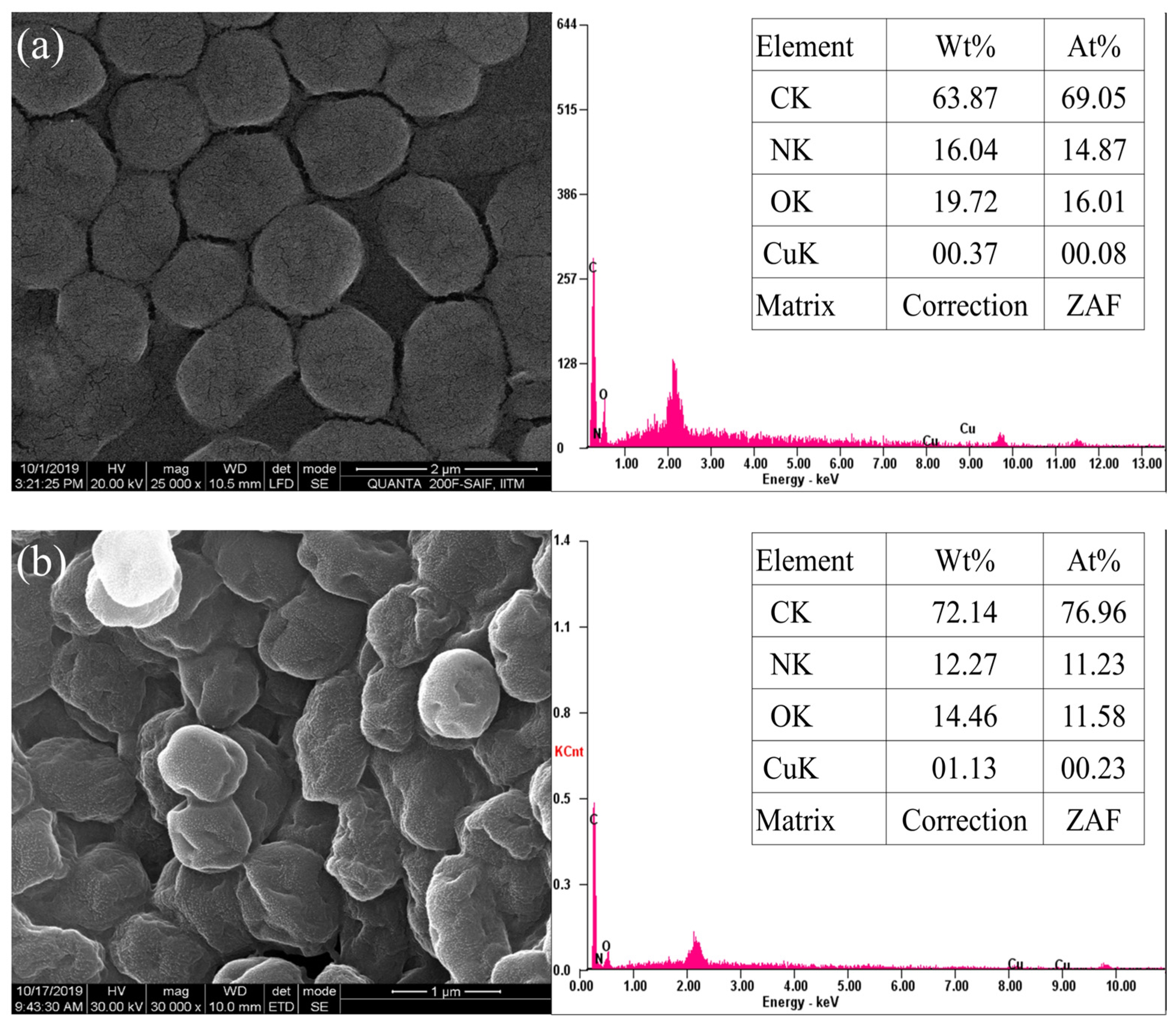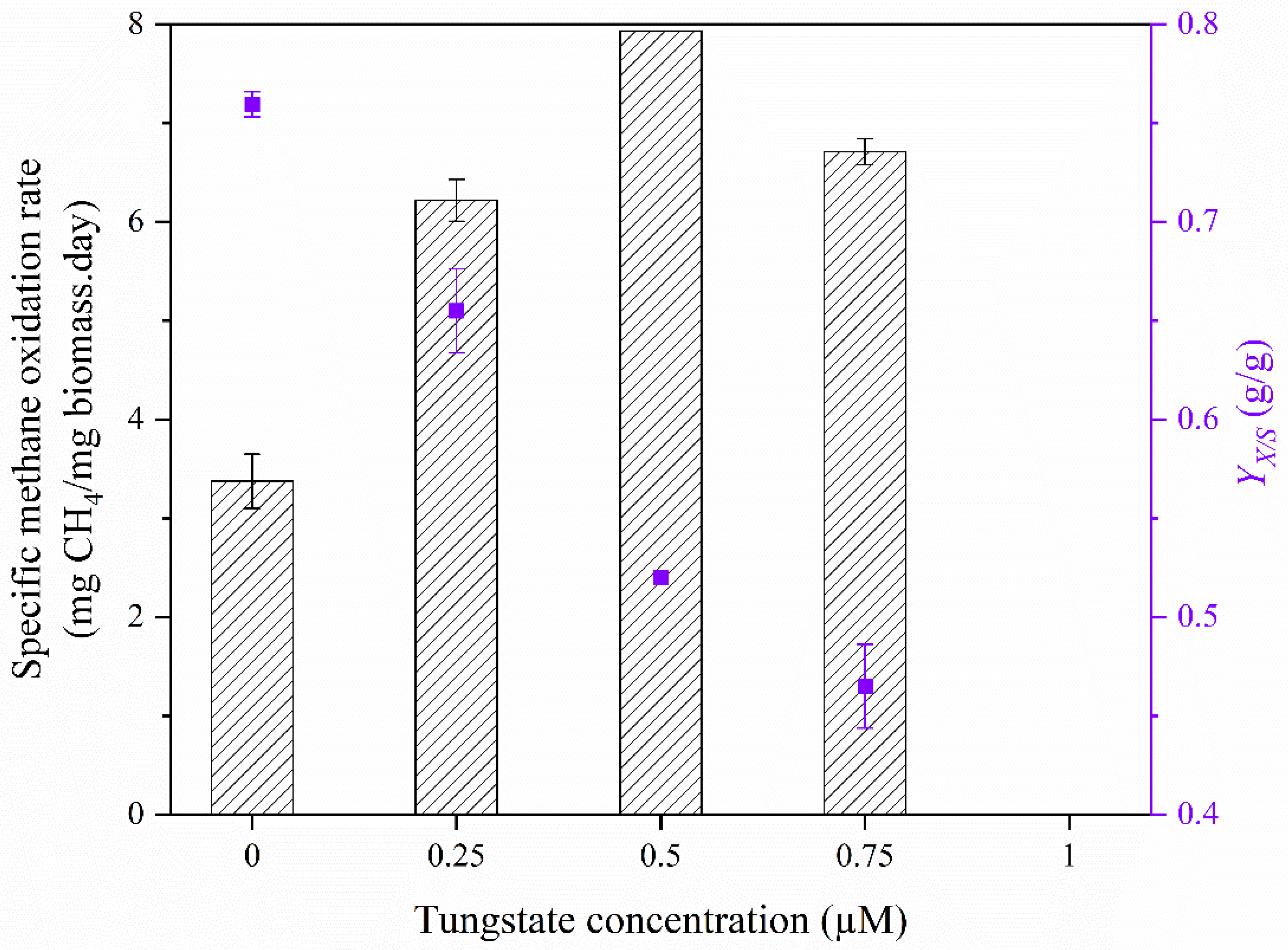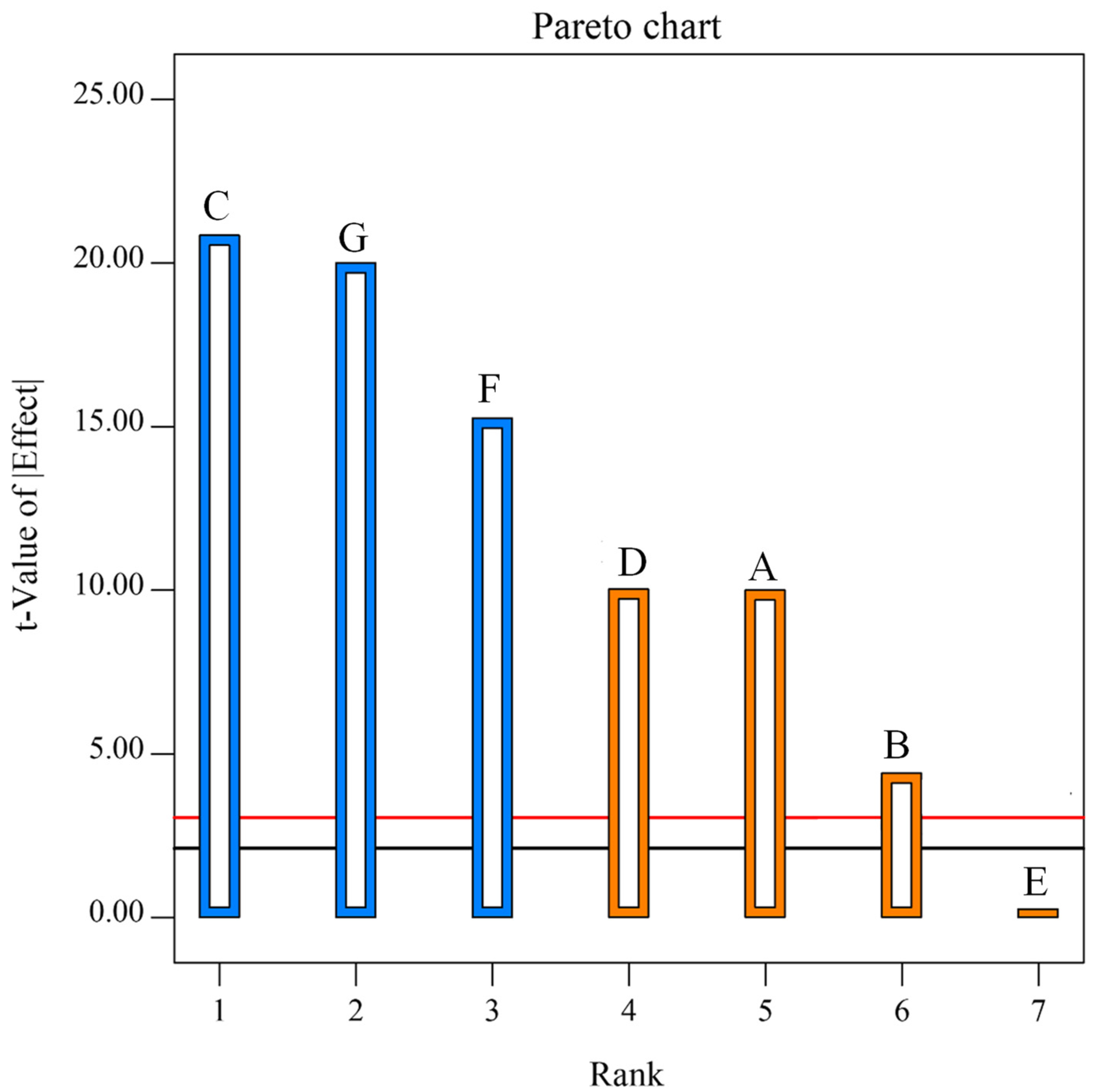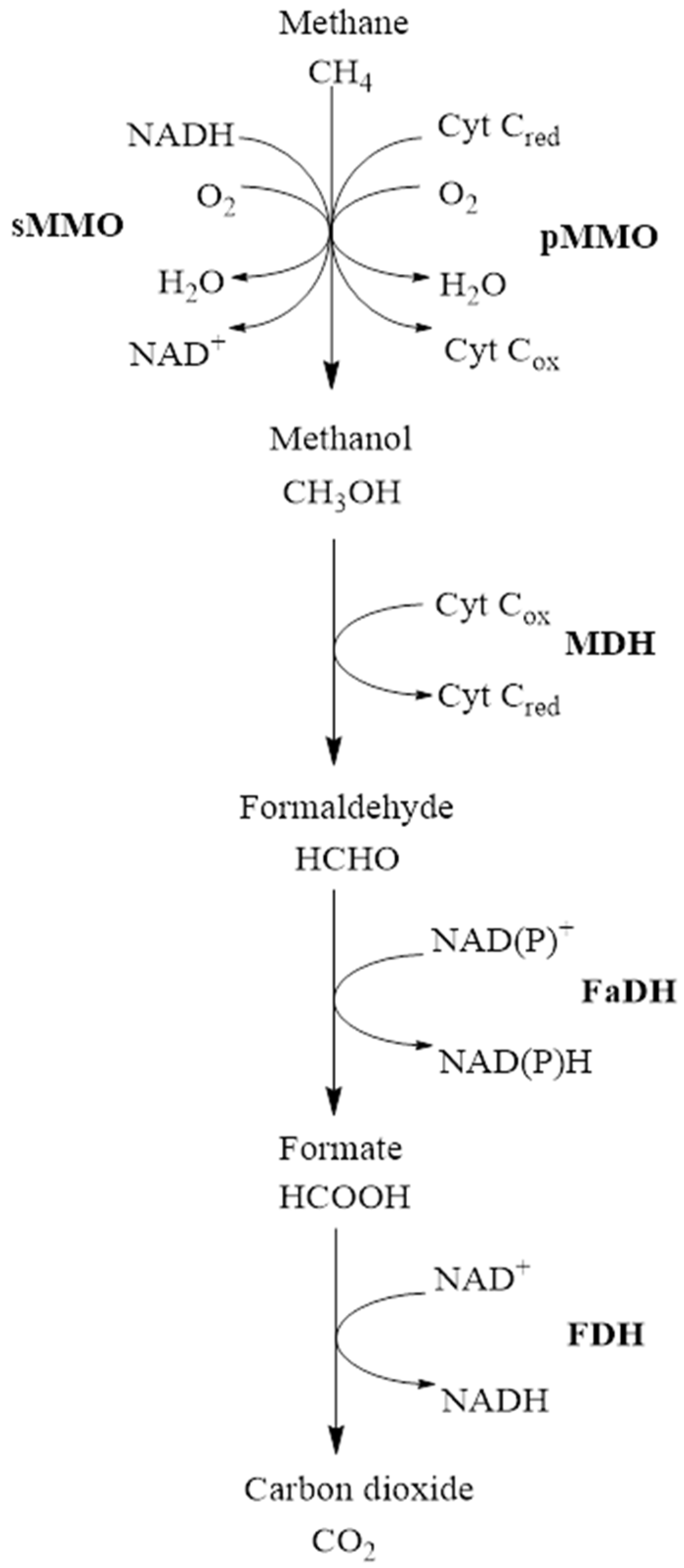Enhanced Bioconversion of Methane to Biodiesel by Methylosarcina sp. LC-4
Abstract
1. Introduction
2. Materials and Methods
2.1. Culture and Growth Conditions
2.2. Assessing the Effect of Trace Metal Ions on Methane Oxidation
2.3. Scanning Electron Microscopy with Energy Dispersive X-ray Analysis (SEM-EDX)
2.4. Transesterification and Extraction of Fatty Acid Methyl Esters from Biomass
2.5. Optimization of Media Components by Plackett–Burman Design Method
2.6. Analytical Techniques
2.6.1. Ultraviolet (UV)-Visible Spectrophotometer
2.6.2. Gas Chromatography (GC)
- Gas analysis
- FAME analysis
3. Results
3.1. Effect of Metal Ions on Methane Oxidation Rates
3.1.1. Copper
3.1.2. Cerium
3.1.3. Tungstate
3.2. Determination of Significant Components in the NMS Media Using the Plackett–Burman Design (PBD)
3.3. Effect of Optimized Media on FAME Content and Composition
4. Discussion
5. Summary and Conclusions
Supplementary Materials
Author Contributions
Funding
Institutional Review Board Statement
Informed Consent Statement
Data Availability Statement
Acknowledgments
Conflicts of Interest
References
- Keasling, J.; Garcia Martin, H.; Lee, T.S.; Mukhopadhyay, A.; Singer, S.W.; Sundstrom, E. Microbial Production of Advanced Biofuels. Nat. Rev. Microbiol. 2021, 19, 701–715. [Google Scholar] [CrossRef] [PubMed]
- Ahmad, F.B.; Zhang, Z.; Doherty, W.O.S.; O’Hara, I.M. A Multi-Criteria Analysis Approach for Ranking and Selection of Microorganisms for the Production of Oils for Biodiesel Production. Bioresour. Technol. 2015, 190, 264–273. [Google Scholar] [CrossRef] [PubMed]
- Blanch, H.W.; Simmons, B.A.; Klein-Marcuschamer, D. Biomass Deconstruction to Sugars. Biotechnol. J. 2011, 6, 1086–1102. [Google Scholar] [CrossRef] [PubMed]
- Zhang, L.; Loh, K.C.; Kuroki, A.; Dai, Y.; Tong, Y.W. Microbial Biodiesel Production from Industrial Organic Wastes by Oleaginous Microorganisms: Current Status and Prospects. J. Hazard. Mater. 2021, 402, 123543. [Google Scholar] [CrossRef] [PubMed]
- Fei, Q.; Guarnieri, M.T.; Tao, L.; Laurens, L.M.L.; Dowe, N.; Pienkos, P.T. Bioconversion of Natural Gas to Liquid Fuel: Opportunities and Challenges. Biotechnol. Adv. 2014, 32, 596–614. [Google Scholar] [CrossRef] [PubMed]
- Zhang, C.; Ottenheim, C.; Weingarten, M.; Ji, L.H. Microbial Utilization of Next-Generation Feedstocks for the Biomanufacturing of Value-Added Chemicals and Food Ingredients. Front. Bioeng. Biotechnol. 2022, 10, 874612. [Google Scholar] [CrossRef] [PubMed]
- Holmes, D.E.; Smith, J.A. Biologically Produced Methane as a Renewable Energy Source. Adv. Appl. Microbiol. 2016, 97, 1–61. [Google Scholar] [CrossRef]
- Comer, A.D.; Long, M.R.; Reed, J.L.; Pfleger, B.F. Flux Balance Analysis Indicates That Methane Is the Lowest Cost Feedstock for Microbial Cell Factories. Metab. Eng. Commun. 2017, 5, 26–33. [Google Scholar] [CrossRef]
- McArthur, J.-A. Methane Emissions Are Driving Climate Change. Here’s How to Reduce Them. Available online: https://www.unep.org/news-and-stories/story/methane-emissions-are-driving-climate-change-heres-how-reduce-them (accessed on 15 July 2022).
- Haynes, C.A.; Gonzalez, R. Rethinking Biological Activation of Methane and Conversion to Liquid Fuels. Nat. Chem. Biol. 2014, 10, 331–339. [Google Scholar] [CrossRef]
- Karakurt, I.; Aydin, G.; Aydiner, K. Sources and Mitigation of Methane Emissions by Sectors: A Critical Review. Renew. Energy 2012, 39, 40–48. [Google Scholar] [CrossRef]
- Gebauer, J.P.; Kaltschmitt, M. Bio-Gtl Processes. In Energy from Organic Materials (Biomass); Springer: New York, NY, USA, 2019; pp. 1145–1174. [Google Scholar]
- Zappi, A.; Fortela, D.L.; Holmes, W.E. An Assessment of Methanotrophs Producing Industrial-Grade Lipids for Biofuels and Other Commercial Chemicals. Energies 2020, 13, 3887. [Google Scholar] [CrossRef]
- Guerrero-Cruz, S.; Vaksmaa, A.; Horn, M.A.; Niemann, H.; Pijuan, M.; Ho, A. Methanotrophs: Discoveries, Environmental Relevance, and a Perspective on Current and Future Applications. Front. Microbiol. 2021, 12, 678057. [Google Scholar] [CrossRef] [PubMed]
- Kim, I.T.; Ahn, K.H.; Lee, Y.E.; Jeong, Y.; Park, J.R.; Shin, D.C.; Jung, J. An Experimental Study on the Biological Fixation and Effective Use of Carbon Using Biogas and Bacterial Community Dominated by Methanotrophs, Methanol-Oxidizing Bacteria, and Ammonia-Oxidizing Bacteria. Catalysts 2021, 11, 1342. [Google Scholar] [CrossRef]
- Strong, P.J.; Xie, S.; Clarke, W.P. Methane as a Resource: Can the Methanotrophs Add Value? Environ. Sci. Technol. 2015, 49, 4001–4018. [Google Scholar] [CrossRef] [PubMed]
- Gęsicka, A.; Oleskowicz-Popiel, P.; Łężyk, M. Recent Trends in Methane to Bioproduct Conversion by Methanotrophs. Biotechnol. Adv. 2021, 53, 107861. [Google Scholar] [CrossRef]
- Kalyuzhnaya, M.G. Methane Biocatalysis: Selecting the Right Microbe. In Biotechnology for Biofuel Production and Optimization; Elsevier: Amsterdam, The Netherlands, 2016; pp. 353–383. ISBN 9780444634757. [Google Scholar]
- Gilman, A.; Laurens, L.M.; Puri, A.W.; Chu, F.; Pienkos, P.T.; Lidstrom, M.E. Bioreactor Performance Parameters for an Industrially-Promising Methanotroph Methylomicrobium Buryatense 5GB1. Microb. Cell Factories 2015, 14, 182. [Google Scholar] [CrossRef]
- Dong, T.; Fei, Q.; Genelot, M.; Smith, H.; Laurens, L.M.L.; Watson, M.J.; Pienkos, P.T. A Novel Integrated Biorefinery Process for Diesel Fuel Blendstock Production Using Lipids from the Methanotroph, Methylomicrobium Buryatense. Energy Convers. Manag. 2017, 140, 62–70. [Google Scholar] [CrossRef]
- Hanson, R.S.; Hanson, T.E. Methanotrophic Bacteria. Microbiol. Rev. 1996, 60, 439–471. [Google Scholar] [CrossRef]
- Nivedita, S.; Arnepalli, D.N.; Krishnan, C. Kinetics and Stoichiometry of an Efficient Methanotroph Methylosarcina Sp. LC-4 Isolated from a Municipal Solid Waste Dumpsite. J. Environ. Eng. 2021, 147, 04021011. [Google Scholar] [CrossRef]
- Whiddon, K.T.; Gudneppanavar, R.; Hammer, T.J.; West, D.A.; Konopka, M.C. Fluorescence-based Analysis of the Intracytoplasmic Membranes of Type I Methanotrophs. Microb. Biotechnol. 2019, 12, 1024–1033. [Google Scholar] [CrossRef]
- D’Ambrosio, V.; Scelsi, E.; Pastore, C. Non-Edible Oils for Biodiesel Production. In Biodiesel Production; John Wiley & Sons, Ltd.: New Jersey, NJ, USA, 2022; pp. 49–66. [Google Scholar]
- Chamola, R.; Khan, M.F.; Raj, A.; Verma, M.; Jain, S. Response Surface Methodology Based Optimization of in Situ Transesterification of Dry Algae with Methanol, H2SO4 and NaOH. Fuel 2019, 239, 511–520. [Google Scholar] [CrossRef]
- Pereira, E.; Napp, A.; Braun, J.V.; Fontoura, L.A.M.; Seferin, M.; Ayres, J.; Ligabue, R.; Passaglia, L.M.P.; Vainstein, M.H. Development and Validation of Analytical Methodology by GC-FID Using Hexadecyl Propanoate as an Internal Standard to Determine the Bovine Tallow Methyl Esters Content. J. Chromatogr. B 2018, 1093–1094, 134–140. [Google Scholar] [CrossRef] [PubMed]
- Semrau, J.D.; Dispirito, A.A.; Yoon, S. Methanotrophs and Copper. FEMS Microbiol. Rev. 2010, 34, 496–531. [Google Scholar] [CrossRef]
- Picone, N.; Op den Camp, H.J. Role of Rare Earth Elements in Methanol Oxidation. Curr. Opin. Chem. Biol. 2019, 49, 39–44. [Google Scholar] [CrossRef] [PubMed]
- Urban, T.; Jarstrand, C. Nitroblue Tetrazolium (NBT) Reduction by Bacteria. Acta Pathol. Microbiol. Scand. Sect. B Microbiol. 2009, 87B, 227–233. [Google Scholar] [CrossRef]
- Wang, H.; Wang, F.; Tao, X.; Cheng, H. Ammonia-containing dimethyl sulfoxide: An improved solvent for the dissolution of formazan crystals in the 3-(4,5-dimethylthiazol-2-yl)-2,5-diphenyl tetrazolium bromide (MTT) assay. Anal. Biochem. 2012, 421, 324–326. [Google Scholar] [CrossRef]
- Ross, M.O.; Rosenzweig, A.C. A Tale of Two Methane Monooxygenases. J. Biol. Inorg. Chem. 2017, 22, 307–319. [Google Scholar] [CrossRef]
- Semrau, J.D.; DiSpirito, A.A.; Vuilleumier, S. Facultative Methanotrophy: False Leads, True Results, and Suggestions for Future Research. FEMS Microbiol. Lett. 2011, 323, 1–12. [Google Scholar] [CrossRef]
- Semrau, J.D.; DiSpirito, A.A.; Gu, W.; Yoon, S. Metals and Methanotrophy. Appl. Environ. Microbiol. 2018, 84, e02289-17. [Google Scholar] [CrossRef]
- Chidambarampadmavathy, K.; Obulisamy, P.K.; Heimann, K. Role of Copper and Iron in Methane Oxidation and Bacterial Biopolymer Accumulation. Eng. Life Sci. 2015, 15, 387–399. [Google Scholar] [CrossRef]
- Culpepper, M.A.; Rosenzweig, A.C. Structure and Protein-Protein Interactions of Methanol Dehydrogenase from Methylococcus Capsulatus (Bath). Biochemistry 2014, 53, 6211–6219. [Google Scholar] [CrossRef] [PubMed]
- Deng, Y.W.; Ro, S.Y.; Rosenzweig, A.C. Structure and Function of the Lanthanide-Dependent Methanol Dehydrogenase XoxF from the Methanotroph Methylomicrobium Buryatense 5GB1C. J. Biol. Inorg. Chem. 2018, 23, 1037–1047. [Google Scholar] [CrossRef] [PubMed]
- Akberdin, I.R.; Collins, D.A.; Hamilton, R.; Oshchepkov, D.Y.; Shukla, A.K.; Nicora, C.D.; Nakayasu, E.S.; Adkins, J.N.; Kalyuzhnaya, M.G. Rare Earth Elements Alter Redox Balance in Methylomicrobium Alcaliphilum 20ZR. Front. Microbiol. 2018, 9, 1–12. [Google Scholar] [CrossRef] [PubMed]
- Hartmann, T.; Schwanhold, N.; Leimkühler, S. Assembly and Catalysis of Molybdenum or Tungsten-Containing Formate Dehydrogenases from Bacteria. Biochim. Et Biophys. Acta Proteins Proteom. 2015, 1854, 1090–1100. [Google Scholar] [CrossRef] [PubMed]
- Bak, S.Y.; Kang, S.G.; Choi, K.H.; Park, Y.R.; Lee, E.Y.; Park, B.J. Phase-Transfer Biocatalytic Methane-to-Methanol Conversion Using the Spontaneous Phase-Separable Membrane ΜCSTR. J. Ind. Eng. Chem. 2022, 111, 389–397. [Google Scholar] [CrossRef]
- Meraz, J.L.; Dubrawski, K.L.; Abbadi, S.H.E.; Choo, K.-H.; Criddle, C.S. Membrane and Fluid Contactors for Safe and Efficient Methane Delivery in Methanotrophic Bioreactors. J. Environ. Eng. 2020, 146, 03120006. [Google Scholar] [CrossRef]
- Klöckner, W.; Gacem, R.; Anderlei, T.; Raven, N.; Schillberg, S.; Lattermann, C.; Büchs, J. Correlation between Mass Transfer Coefficient KLa and Relevant Operating Parameters in Cylindrical Disposable Shaken Bioreactors on a Bench-to-Pilot Scale. J. Biol. Eng. 2013, 7, 1–14. [Google Scholar] [CrossRef]
- Midgley, J.W.; Rutter, G.A.; Thomas, A.P.; Denton, R.M. Effects of Ca2+ and Mg2+ on the Activity of Pyruvate Dehydrogenase Phosphate Phosphatase within Toluene-Permeabilized Mitochondria. Biochem. J. 1987, 241, 371–377. [Google Scholar] [CrossRef]
- Patel, S.K.S.; Shanmugam, R.; Kalia, V.C.; Lee, J.K. Methanol Production by Polymer-Encapsulated Methanotrophs from Simulated Biogas in the Presence of Methane Vector. Bioresour. Technol. 2020, 304, 123022. [Google Scholar] [CrossRef]
- Anto, S.; Pugazhendhi, A.; Mathimani, T. Lipid Enhancement through Nutrient Starvation in Chlorella Sp. and Its Fatty Acid Profiling for Appropriate Bioenergy Feedstock. Biocatal. Agric. Biotechnol. 2019, 20, 101179. [Google Scholar] [CrossRef]
- Kumar, R.; Dhanarajan, G.; Sarkar, D.; Sen, R. Multi-Fold Enhancement in Sustainable Production of Biomass, Lipids and Biodiesel from Oleaginous Yeast: An Artificial Neural Network-Genetic Algorithm Approach. Sustain. Energy Fuels 2020, 4, 6075–6084. [Google Scholar] [CrossRef]
- Scanlan, J.; Guillonneau, R.; Cunningham, M.R.; Najmin, S.; Mausz, M.A.; Murphy, A.; Murray, L.L.; Zhang, L.; Kumaresan, D.; Chen, Y. The Proteobacterial Methanotroph Methylosinus Trichosporium OB3b Remodels Membrane Lipids in Response to Phosphate Limitation. Front. Microbiol. 2022, 13, 1–14. [Google Scholar] [CrossRef] [PubMed]
- Strong, P.J.; Kalyuzhnaya, M.; Silverman, J.; Clarke, W.P. A Methanotroph-Based Biorefinery: Potential Scenarios for Generating Multiple Products from a Single Fermentation. Bioresour. Technol. 2016, 215, 314–323. [Google Scholar] [CrossRef] [PubMed]
- AlSayed, A.; Fergala, A.; Khattab, S.; ElSharkawy, A.; Eldyasti, A. Optimization of Methane Bio-Hydroxylation Using Waste Activated Sludge Mixed Culture of Type I Methanotrophs as Biocatalyst. Appl. Energy 2018, 211, 755–763. [Google Scholar] [CrossRef]
- Burdette, M.D. Production of Biodiesel-like Components by the Type I Methanotroph Methylomonas Methanica. Master’s Thesis, Clemson University, South Carolina, SC, USA, August 2013. [Google Scholar]
- Tays, C.; Guarnieri, M.T.; Sauvageau, D.; Stein, L.Y. Combined Effects of Carbon and Nitrogen Source to Optimize Growth of Proteobacterial Methanotrophs. Front. Microbiol. 2018, 9, 2239. [Google Scholar] [CrossRef] [PubMed]





| Component | Unit | Designation | Coded Values | |
|---|---|---|---|---|
| −1 | +1 | |||
| Nitrogen (KNO3) | mM | A | 1 | 10 |
| Phosphorus (KH2PO4 -Na2HPO4 buffer) | mM | B | 0.42 | 4.20 |
| Copper (CuSO4) | μM | C | 10 | 75 |
| Tungstate (Na2WO4) | μM | D | 0 | 0.5 |
| Cerium (CeCl3) | μM | E | 0 | 10 |
| Magnesium (MgSO4) | mM | F | 0.81 | 8.10 |
| Salinity (NaCl) | mM | G | 0 | 171 |
| Run | A | B | C | D | E | F | G | Biomass (mg/L) | FAME Yield (mg/L) |
|---|---|---|---|---|---|---|---|---|---|
| 1. | +1 | −1 | −1 | −1 | +1 | +1 | +1 | 56 ± 1.3 | 6.3 ± 0.1 |
| 2. | +1 | +1 | −1 | −1 | −1 | +1 | +1 | 53 ± 3.4 | 5.4 ± 0.4 |
| 3. | +1 | +1 | +1 | −1 | −1 | −1 | +1 | 38.8 ± 3 | 4.1 ± 0.3 |
| 4. | +1 | +1 | +1 | +1 | −1 | −1 | −1 | 302.2 ± 9.5 | 48.7 ± 1.6 |
| 5. | −1 | +1 | +1 | +1 | +1 | −1 | −1 | 293.3 ± 1 | 30.7 ± 3.5 |
| 6. | −1 | −1 | +1 | +1 | +1 | +1 | −1 | 42 ± 2 | 4.6 ± 0.2 |
| 7. | −1 | −1 | −1 | +1 | +1 | +1 | +1 | 57.6 ± 2.5 | 5.9 ± 0.3 |
| 8. | −1 | −1 | −1 | −1 | −1 | −1 | −1 | 312.7 ± 11.6 | 32.7 ± 1.2 |
| Symbol | Component | Effect | Contribution (%) | F-Value | p-Value |
|---|---|---|---|---|---|
| A | Nitrogen | 14.46 | 7.6 | 85.44 | <0.0001 |
| B | Phosphorus | 6.45 | 1.5 | 16.99 | 0.0008 |
| C | Copper | −30 | 33.3 | 367.93 | <0.0001 |
| D | Tungstate | 14.25 | 7.7 | 83.05 | <0.0001 |
| E | Cerium | 0.39 | 0.005 | 0.06 | 0.81 |
| F | Magnesium | −21.99 | 17.8 | 197.6 | <0.0001 |
| G | Salinity (NaCl) | −28.80 | 30.7 | 339.05 | <0.0001 |
| FAME (mg/L) | NMS Media | NMS Modified Media |
|---|---|---|
| 28 | 52 | |
| FAME composition | ||
| C14:0 | 3.87 | 7.31 |
| ƩC14:1 | 5.59 | 7.78 |
| C15:0 | 2.76 | 14.03 |
| ƩC15:1 | - | 10.78 |
| C16:0 | 23.49 | 26.37 |
| ƩC16:1 | 34.09 | 17.77 |
| C18:0 | 5.17 | 9.63 |
| ƩC18:1 | - | 6.76 |
| C14–C18 | 97.58 | 89.65 |
| C14–C18 unsaturated FAME | 50.46 | 32.31 |
| C14–C18 saturated FAME | 47.12 | 57.34 |
| Total unsaturated FAME | 52.1 | 34.43 |
| Total saturated FAME | 47.9 | 65.61 |
Disclaimer/Publisher’s Note: The statements, opinions and data contained in all publications are solely those of the individual author(s) and contributor(s) and not of MDPI and/or the editor(s). MDPI and/or the editor(s) disclaim responsibility for any injury to people or property resulting from any ideas, methods, instructions or products referred to in the content. |
© 2022 by the authors. Licensee MDPI, Basel, Switzerland. This article is an open access article distributed under the terms and conditions of the Creative Commons Attribution (CC BY) license (https://creativecommons.org/licenses/by/4.0/).
Share and Cite
Sana, N.; Arnepalli, D.N.; Krishnan, C. Enhanced Bioconversion of Methane to Biodiesel by Methylosarcina sp. LC-4. Sustainability 2023, 15, 505. https://doi.org/10.3390/su15010505
Sana N, Arnepalli DN, Krishnan C. Enhanced Bioconversion of Methane to Biodiesel by Methylosarcina sp. LC-4. Sustainability. 2023; 15(1):505. https://doi.org/10.3390/su15010505
Chicago/Turabian StyleSana, Nivedita, Dali Naidu Arnepalli, and Chandraraj Krishnan. 2023. "Enhanced Bioconversion of Methane to Biodiesel by Methylosarcina sp. LC-4" Sustainability 15, no. 1: 505. https://doi.org/10.3390/su15010505
APA StyleSana, N., Arnepalli, D. N., & Krishnan, C. (2023). Enhanced Bioconversion of Methane to Biodiesel by Methylosarcina sp. LC-4. Sustainability, 15(1), 505. https://doi.org/10.3390/su15010505





